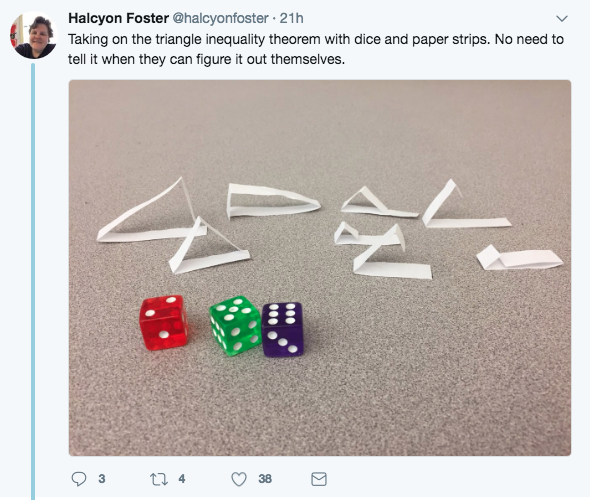Exploring the Triangle Inequality Theorem
I know... sounds exciting right? Please bear with me... I was inspired today! As a geometry teacher, I am always looking for ways to visualize and demonstrate geometric concepts. Often times, I utilize tools like GeoGebra or Desmos. But frequently, geometry can utilize simple resources.
This morning, I came across a tweet from Halcyon Foster:









This morning, I came across a tweet from Halcyon Foster:
I really like how this utilizes simple materials that most geometry teachers have - paper, ruler, scissors, and dice. It looks like the idea is to roll the dice, then take a strip of paper and measure and divide it into lengths (in this case 2cm, 5cm & 6cm). Then fold the strip to try to make a triangle. It's simple and effective, and serves as a great way to investigate the triangle inequality theorem.
It inspired me to think of a way to "kick it up a notch". So I turned to one of my favorite geometry tools - bendy drinking straws! Here is what I put together:
Supplies:
- Bendy straws
- Scissors
- Ruler
- Sharpie
- Ziploc Bag
- Three Dice
Assembly:
1. Use as many straws as needed so that you have 3 straw sections of 1”, 2”, 3”, 4”, 5”, and 6” in length.
2. Label the lengths of each straw. These will become the sides of the straw triangles.
3. Take the bendy parts and trim them to a length of 1” on both sides of the bendy section.
4. Insert scissors in the end of the 1” length of the bendy piece, and cut a slit up to the bendy section. Be careful not to cut the bendy section!
5. To assemble the triangle, curl the end of the bendy piece (similar to rolling up a poster), and insert the curled end into the “straw sides”. Repeat with two more bendy pieces and two more “straw sides” to make a triangle.
6. Use a Ziploc bag to hold your straws and dice.
Activities:
- Discovering the Triangle Inequality Theorem
1. Ask students to roll the three dice. The three numbers on the dice represent the side lengths to use to make a triangle. Students should repeat the process, re-rolling the dice each time.
2. Have students keep track of which side length combinations work/don’t work.
3. Make a tree diagram or sample space and list all of the possible combinations from the set of 1”, 2”, 3”, 4”, 5” & 6” (three of each) straws. Ask the students to predict - “Will the majority of these combinations work or not?” Determine if each one works/doesn’t work.
4. Ask students to make a conjecture about why some combinations work and why some don’t work. (aka “What’s the rule”?)
For a link to a Google Doc with the same instructions, click HERE.
Questions/comments/suggestions? Please feel free to contact me! Thanks again to Halcyon for the inspiration!




Comments
Post a Comment